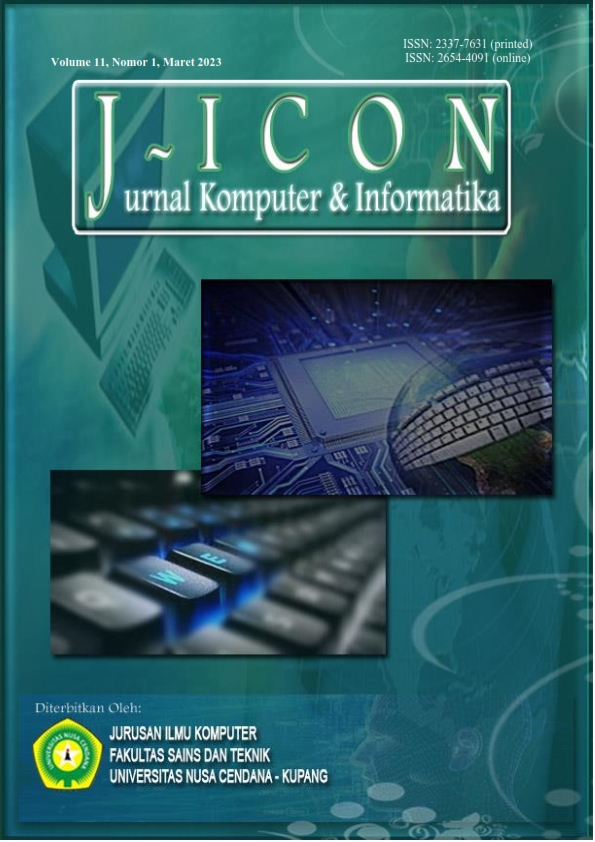EVALUATION OF BALAP KARUNG 3D GAME INTERFACE USING THE SYSTEM USABILITY SCALE (SUS) METHOD
Abstract
Traditional games are a form of knowledge passed down from generation to generation. An example of a traditional game is Balap Karung. Currently, many game developers have created the "Balap Karung" application, but it has deficiencies in its User Interface. The User Interface is one of the visual elements that build a game. The User Interface is a communication mechanism between the user and the system that can receive information and provide information to the user to help direct the navigation flow until the user finds the solution. Creating a user interface in the 3D" Balap Karung" game as a visual design for the "Balap Karung" game will be built on an Android-based system. Creating a graphic user interface is done by researching the use of color in the user interface. The colors that match the "Balap Karung" game style will be used. The System Usability Scale (SUS) method was used as a usability test for the "Balap Karung" game. Through the results of game testing using the SUS method by distributing online questionnaires to be filled out by the respondents after they played the "Balap Karung" game, was obtained the average SUS score of 69.42 after calculating the results of the questionnaires from the respondents. According to the scores, it can conclude that the usability of the "Balap Karung" game is said to be good, with buttons and visuals following the purpose of their respective functions. According to the theory of calculating the SUS score, a score of 69.42, the "Balap Karung" game gets a Good rating in terms of usability.
Downloads
References
Y. Mulyana and A. S. Lengkana, Permainan tradisional. Salam Insan Mulia, 2019.
B. A. S. Rajab and R. H. Kuswantoro, “Perancangan Permainan Fighting Peresean Sebagai Media Pengenalan Budaya Suku Sasak,” Respati, vol. 13, no. 3, Art. no. 3, Nov 2018, doi: https://doi.org/10.35842/jtir.v13i3.256.
A. Munir, “Pengaruh Permainan Balap Karung dan Egrang terhadap Peningkatan Kepercayaan Diri Anak Usia Dini di PAUD Cahaya Kecamatan Rambutan Kota Tebing Tinggi,” J. Divers., vol. 5, no. 2, hlm. 161–172, Des 2019, doi: https://doi.org/10.31289/diversita.v5i2.3056.
T. F. A. Esa, “Sistem Informasi Unit Kegiatan Mahasiswa Taekwondo Universitas Islam Indonesia,” Thesis, UII, 2016. Diakses: 25 Oktober 2022. [Online]. Available: https://dspace.uii.ac.id/handle/123456789/3752. [Accessed: 2022-10-25].
D. Anggitama, H. Tolle, and H. Az-Zahra, “Evaluasi Dan Perancangan User Interface Untuk Meningkatkan User Experience Menggunakan Metode Human Centered Design Dan Heuristic Evaluation Pada Aplikasi EzyPay,” J. Pengemb. Teknol. Inf. Dan Ilmu Komput., vol. 2, no. 12, hlm. 6152–6159, 2018. Available: https://j-ptiik.ub.ac.id/index.php/j-ptiik/article/view/3543. [Accessed: 2022-10-25].
M. Monica and L. C. Luzar, “Efek Warna dalam Dunia Desain dan Periklanan,” Humaniora, vol. 2, no. 2, Art. no. 2, Okt 2011, doi: https://doi.org/10.21512/humaniora.v2i2.3158.
W. Wibawanto and R. Nugrahani, “Desain Antarmuka (User Interface) pada Permainan Edukasi,” Imajin. J. Seni, vol. 12, no. 2, Art. no. 2, Jul 2018, doi: 10.15294/imajinasi.v12i2.17472.
I. Rochmawati, “User Interface Analysis,” Vis. J. Online Desain Komun. Vis., vol. 7, no. 2, Art. no. 2, Feb 2019, doi: https://doi.org/10.33375/vslt.v7i2.1459.
C. A. Hartono, H. Andika, and E. M. Trianto, “Perancangan dan Pembuatan Aplikasi Permainan Nusantara Indonesia Berbasis Android,” Teknika, vol. 6, no. 1, hlm. 66–72, 2017.Available: https://ejournal.ikado.ac.id/index.php/teknika/article/view/59. [Accessed: 2022-10-25].
M. D. Solihin and A. Trianasari, “Kumpulan Permainan Tradisional Dalam Bentuk Video Permainan Berbasis Android Berjudul Traditional Olympic,” J. Esensi Infokom J. Esensi Sist. Inf. Dan Sist. Komput., vol. 4, no. 2, Art. no. 2, Okt 2020, doi: https://doi.org/10.55886/infokom.v4i2.306.
D. O. Sasongkoro, T. W. Purboyo, and R. Wijaya, "TRADITIONAL SACK RACE GAME BASED ON MOTION CAPTURE USING THE KALMAN FILTER," J. Southwest Jiaotong Univ., vol. 57, no. 2, Art. no. 2, 2022, Accessed: Oct. 28, 2022. [Online]. Available: http://www.jsju.org/index.php/journal/article/view/1221. [Accessed: 2022-10-25].
U. Ependi, T. B. Kurniawan, and F. Panjaitan, “SYSTEM USABILITY SCALE VS HEURISTIC EVALUATION: A REVIEW,” Simetris J. Tek. Mesin Elektro Dan Ilmu Komput., vol. 10, no. 1, pp. 65–74, Apr 2019, doi: https://doi.org/10.24176/simet.v10i1.2725. [Accessed: 2022-10-25].
B. Pudjoatmodjo and R. Wijaya, “Tes Kegunaan (Usabilty Testing) Pada Aplikasi Kepegawaian Dengan Menggunakan System Usabilty Scale (Studi Kasus : Dinas Pertanian Kabupaten Bandung),” SEMNASTEKNOMEDIA ONLINE, vol. 4, no. 1, Art. no. 1, Feb 2016. [Online]. Available: https://ojs.amikom.ac.id/index.php/semnasteknomedia/article/view/1302 .[Accessed: 2022-10-25].
J. Brooke, "SUS: a retrospective," J. Usability Stud., vol. 8, pp. 29–40, Jan 2013.
A. Bangor, P. Kortum, and J. Miller, "Determining What Individual SUS Scores Mean: Adding an Adjective Rating Scale," J Usability Stud., vol. 4, no. 3, pp. 114–123, Mei 2009. [Online]. Available: https://uxpajournal.org/determining-what-individual-sus-scores-mean-adding-an-adjective-rating-scale/ .[Accessed: 2022-10-25].
R. Ramadan and Y. Widyani, "Game Development Life Cycle Guidelines," 2013 Int. Conf. Adv. Comput. Sci. Inf. Syst. ICACSIS, pp. 95–100, 2013. doi: https://doi.org/10.1109/icacsis.2013.6761558.
Copyright (c) 2023 Adi Sucipto, Anugrah Dwirangga, RM. Joko Priyono

This work is licensed under a Creative Commons Attribution 4.0 International License.
The author submitting the manuscript must understand and agree that if accepted for publication, authors retain copyright and grant the journal right of first publication with the work simultaneously licensed under a Creative Commons Attribution (CC-BY) 4.0 License that allows others to share the work with an acknowledgment of the work’s authorship and initial publication in this journal.
 Adi Sucipto(1*)
Adi Sucipto(1*)




